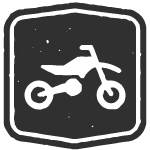
Backcountry Snowsports


If you are out in the shoulder seasons (spring and fall), when conditions are sometimes muddy, stay on snow or walk in the middle of the trail to avoid creating new trails.
TRAVEL RESPONSIBLY
Use terrain to your advantage, avoiding steep slopes, cornices and gullies or depressions. Periodically check for clues to an unstable snowpack. Remember, one person at a time on slopes. Photo Milo McDowell
Travel responsibly on designated roads, trails and areas.
- Travel only in areas designated for your type of winter travel.
- Avoid traveling on frozen waterways and lakes.
- If you are out in the shoulder seasons (spring and fall), when conditions are sometimes muddy, stay on snow or walk in the middle of the trail to avoid creating new trails.
- Comply with signs and respect barriers. Avoid traveling in potential avalanche areas. Use terrain to your advantage, avoiding steep slopes, cornices and gullies or depressions. Periodically check for clues to an unstable snowpack. Remember, one person at a time on slopes.
- Buddy up with two or three skiers or snowshoers, reducing vulnerability if you have an accident.
RESPECT THE RIGHTS OF OTHERS
Respect the rights of others, including private property owners, all recreational trail users, campers and others so they can enjoy their recreational activities undisturbed.
- Be considerate of others on the trail.
- Keep to the right when meeting other winter recreationists and yield the right of way to downhill traffic.
- Respect established ski tracks. If traveling by foot or snowshoe, don’t damage existing ski tracks.
- When stopping, step to the side of the trail to let other skiers and recreationists pass.
- When skiing, move to the right to allow faster skiers to pass.
- If crossing private property, ask permission from the landowner(s).
- Keep pets under control. This protects your pet, other recreationists and wildlife.
EDUCATE YOURSELF
If you are out in the shoulder seasons (spring and fall), when conditions are sometimes muddy, stay on snow or walk in the middle of the trail to avoid creating new trails. Photo by Biegun Wachodni
Educate yourself prior to your trip by obtaining travel maps and regulations from public agencies, planning for your trip, taking recreation skills classes and knowing how to operate your equipment safely.
- Obtain a map of your destination and determine which areas are open to winter travel.
- Make a realistic plan and stick to it. Always tell someone of your travel plans.
- Contact the land manager for area restrictions, closures and permit requirements.
- Always check the weather forecast and avalanche conditions.
- Prepare for the unexpected by packing a small backpack full of emergency items.
- Layer clothing and wear a durable waterproof outer shell and footwear.
- Take an avalanche class. They provide skills on assessing snow conditions, performing rescues and using safety equipment.
- Wear an avalanche transceiver, shovel and probe on your body at all times in avalanche terrain.
- If a person develops hypothermia, warm the person up by rubbing them vigorously and getting them into dry clothes. Give them warm non-alcoholic liquids.
AVOID SENSITIVE AREAS
Avoid sensitive areas such as meadows, lakeshores, wetlands and streams. Stay on designated routes.
- Avoid areas with inadequate snow cover.
- Do not disturb historical, archeological or paleontological sites.
- Be respectful of wildlife’s wintering habitats.
- Avoid “spooking” livestock and wildlife and keep your distance.
DO YOUR PART
When finished with your campsite, demolish any snow walls or shelters you have built. Fill in areas where you have quarried snow blocks. Photo by Ales Krivec
Do your part by modeling appropriate behavior, leaving the area better than you found it, properly disposing of waste, minimizing the use of fire, avoiding the spread of invasive species and restoring degraded areas.
- Pack out what you pack in. Carry a trash bag in your pack and pick up litter left by others.
- When finished with your campsite, demolish any snow walls or shelters you have built. Fill in areas where you have quarried snow blocks.
- If you must have a fire, use a fire pan.
- Dispose of all sanitary waste properly by packing it out or bury it 6 to 8 inches deep in soil.
- Take a small bag and pack out your pets waste especially in front country areas or if it is left on or near trails or trailhead areas.
- Build a trail community. Get to know other types of recreationists that share your favorite trail.














